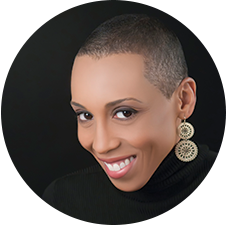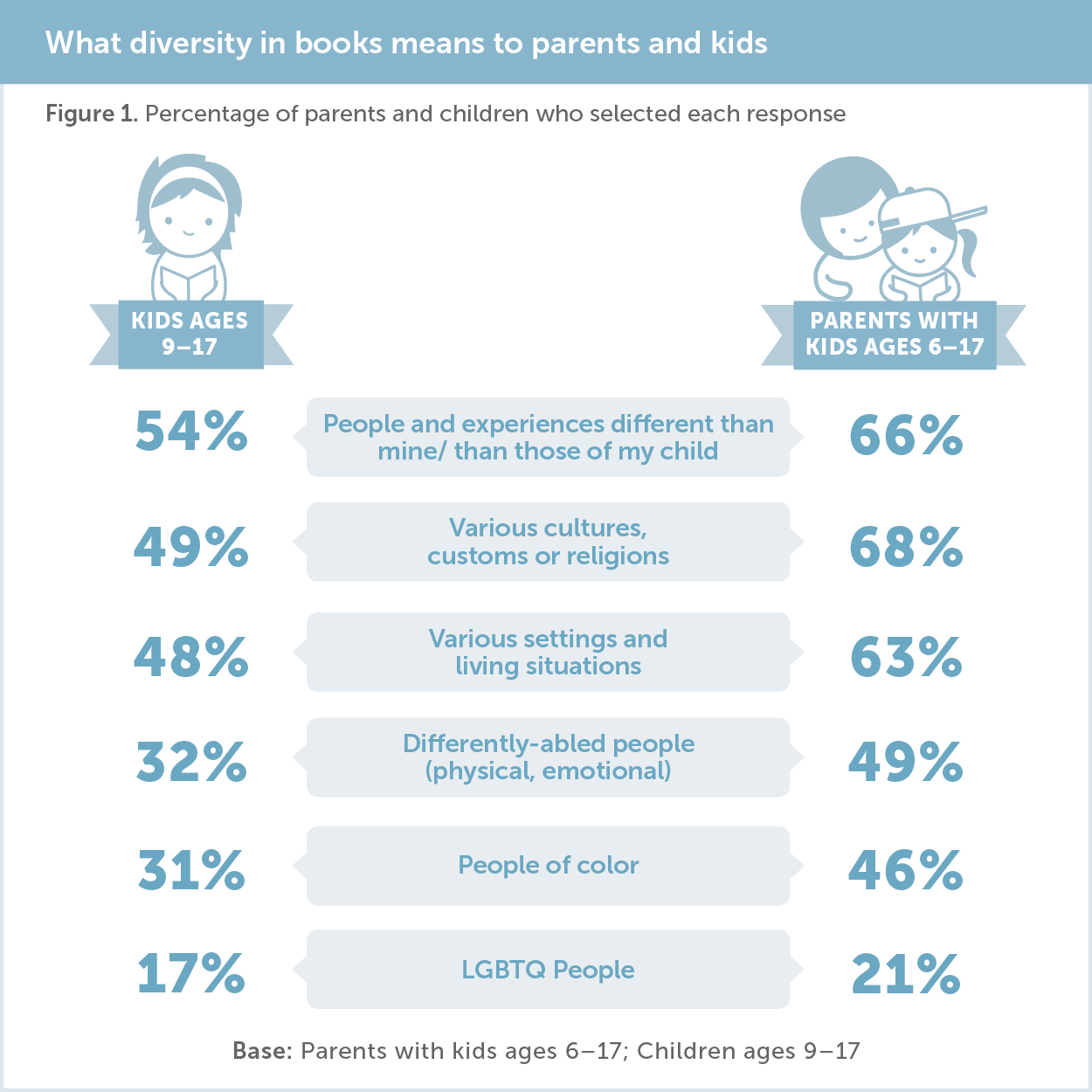
DIVERSITY IN CHILDREN’S BOOKS HAS A HIGHLY-INCLUSIVE MEANING
Diversity in children’s books has a broad meaning among kids and parents. A majority of parents and a near majority of kids ages 9–17 say diversity in children’s books includes people and experiences different than their own, various cultures, customs, religions, settings and living situations. And while not as commonly cited, many believe diversity in children’s books also includes differently-abled people, people of color and LGBTQ people (see Figure 1).
About six in 10 parents (58%) report diversity is extremely or very important in the books their child reads, and nearly four in 10 kids ages 9–17 (38%) agree. When asked why this is important, parents predominantly responded with answers related to learning about differences and understanding the world.
As one father of a 14-year-old girl said, “The world is a diverse place. My child should be able to experience stories of those who are not just like her, or just look like her, or live like her. She should be able to learn that people come in all shapes, sizes, colors, belief systems and educational or cultural backgrounds, so that she is ready to engage with the world in an authentic way.”
Click Here For High-Resolution Image
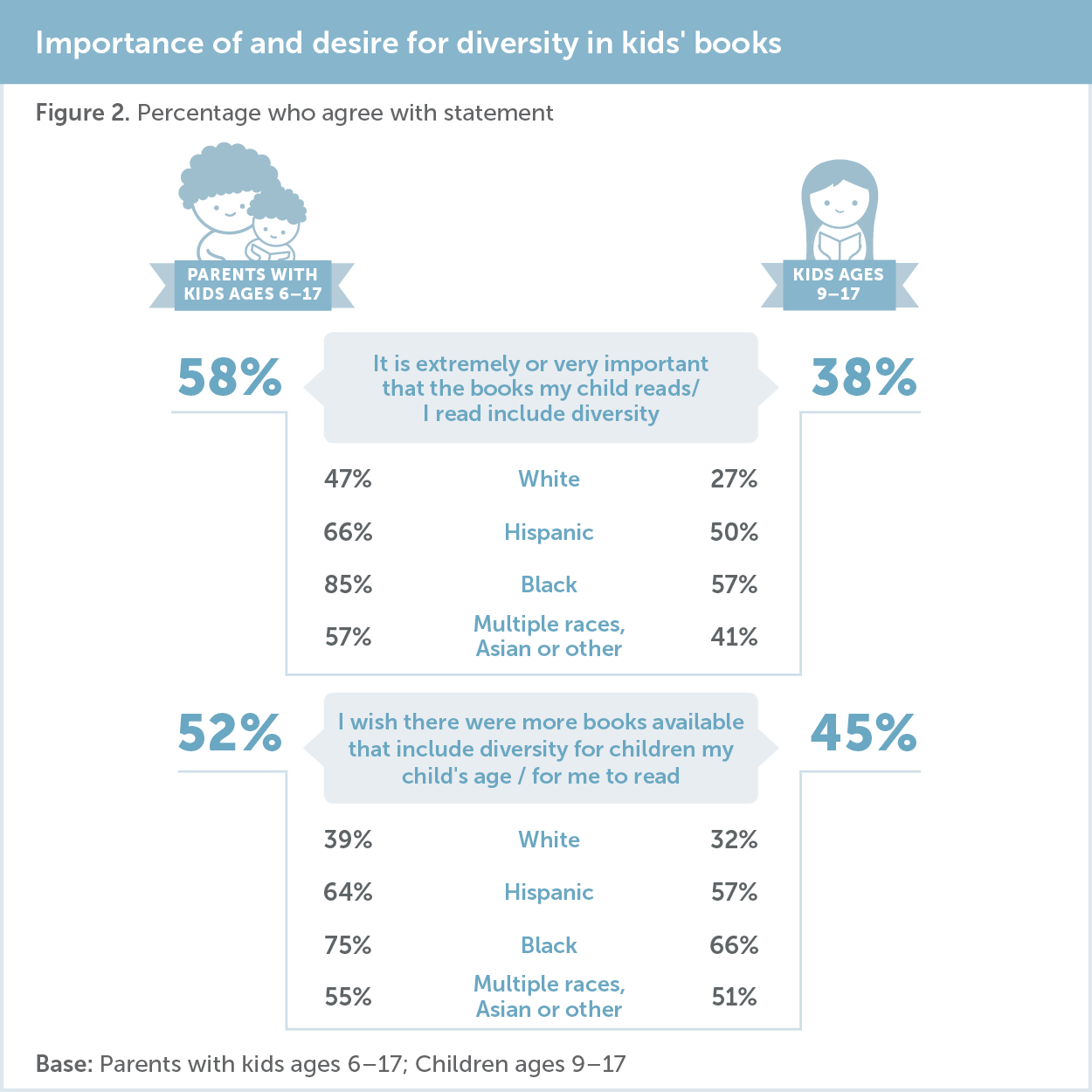
MANY FAMILIES WANT MORE BOOKS TO INCLUDE DIVERSITY
About half of kids ages 9–17 and parents overall agree “I wish there were more books available that include diversity.” This sentiment increases to 76% of kids and 69% of parents who also agree diversity in children’s books is important. The desire for more diverse books is strongest among Black children and their parents, followed by Hispanic families, then by families of multi-racial, Asian or other racial backgrounds (see Figure 2).
The data also suggest that highly-visual reading materials resonate with both parents and children who believe it is important that the books children read include diversity. Parents who say diversity is important are more likely than other parents to prefer their child reads story books (58% vs. 48%), picture books (28% vs. 19%), comic books (27% vs. 15%) and magazines (20% vs. 15%). They are also far more likely to say it is important their child experiences books with characters that look like him/her (59% vs. 25%).
Similarly, children who say reading books with diversity is important to them are more likely to say they like to read story books (47% vs. 30%), and these children are more likely to agree that it is easy to find books with characters that “look like me” (63% vs. 45%).
Click Here For High-Resolution Image
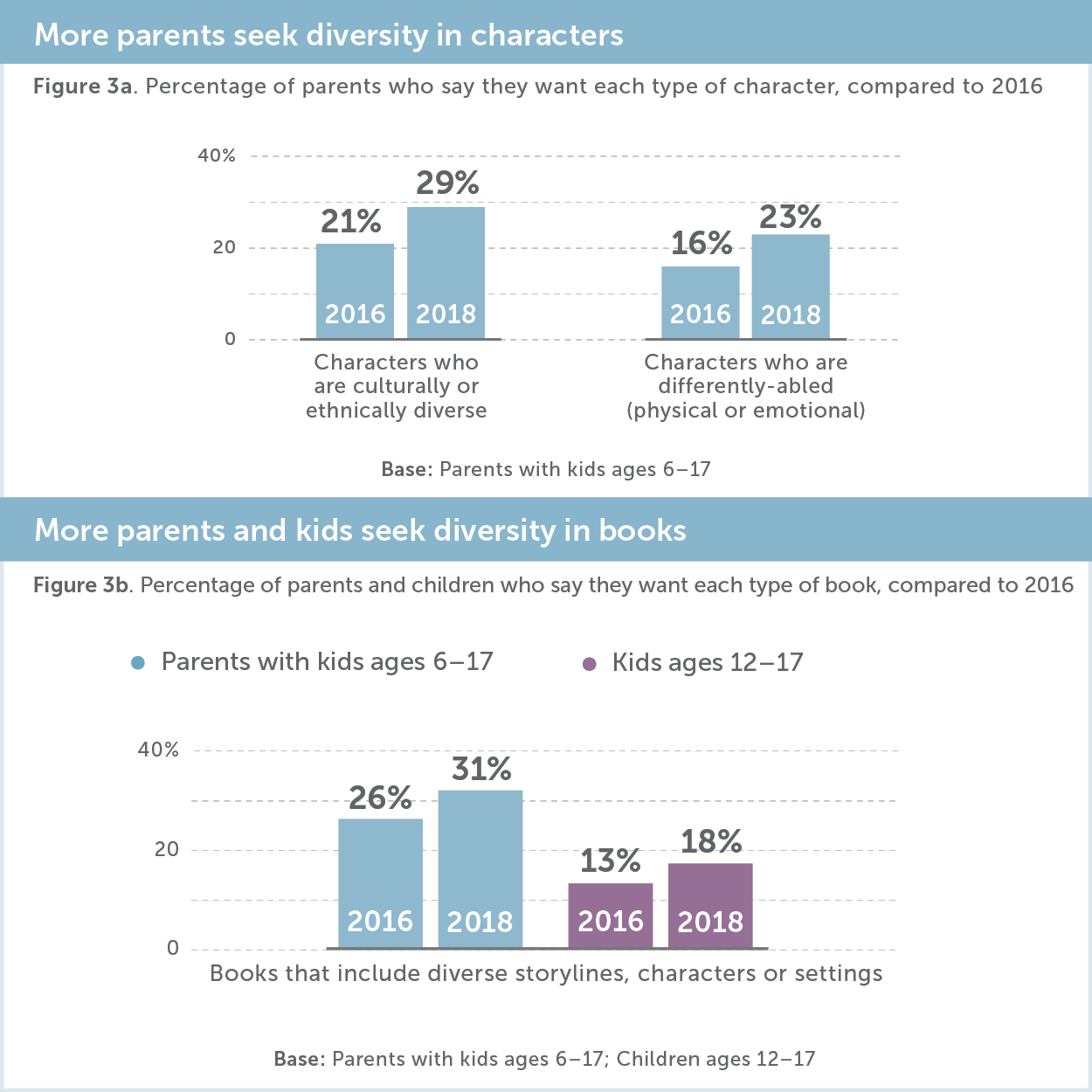
DESIRE FOR DIVERSITY IN CHILDREN’S BOOKS IS ON THE RISE
Both kids ages 12–17 and parents of children across ages are more likely today than they were in 2016 to want books with diverse storylines, characters or settings (18% of kids, up six points; 31% of parents with kids ages 6–17, up five points; parents of children ages 0–5 up nine points to 36%). Since 2016, parents are also more likely to want culturally or ethnically diverse characters (21% to 29%, up eight points) and differently-abled characters (16% to 23%, up seven points) (see Figure 3a/b).
Black and Hispanic families as well as families of multi-racial, Asian or other racial backgrounds are the most likely to look for books that include diverse storylines, characters or settings. Notably, finding these diversity-related characteristics is just as important to parents of Black children as finding books that help their child imagine and understand other people’s lives, make their child think and feel, as well as books that inspire kids to do something good or make them laugh.
Similarly, while just over one in 10 kids ages 9–17 look specifically for characters that are culturally or ethnically diverse, Black children are the most likely to seek out these characters (24% compared to 18% of children of multiple, Asian or other races, 16% of Hispanic children and 7% of white children). One in 10 children ages 9–17 also looks for characters who are differently-abled, and a similar number look for those who break stereotypes. Three percent look for LGBTQ characters. As one 17-year-old girl shared, “Life is different for everyone so I would like to understand the differences.”
Click Here For High-Resolution Image
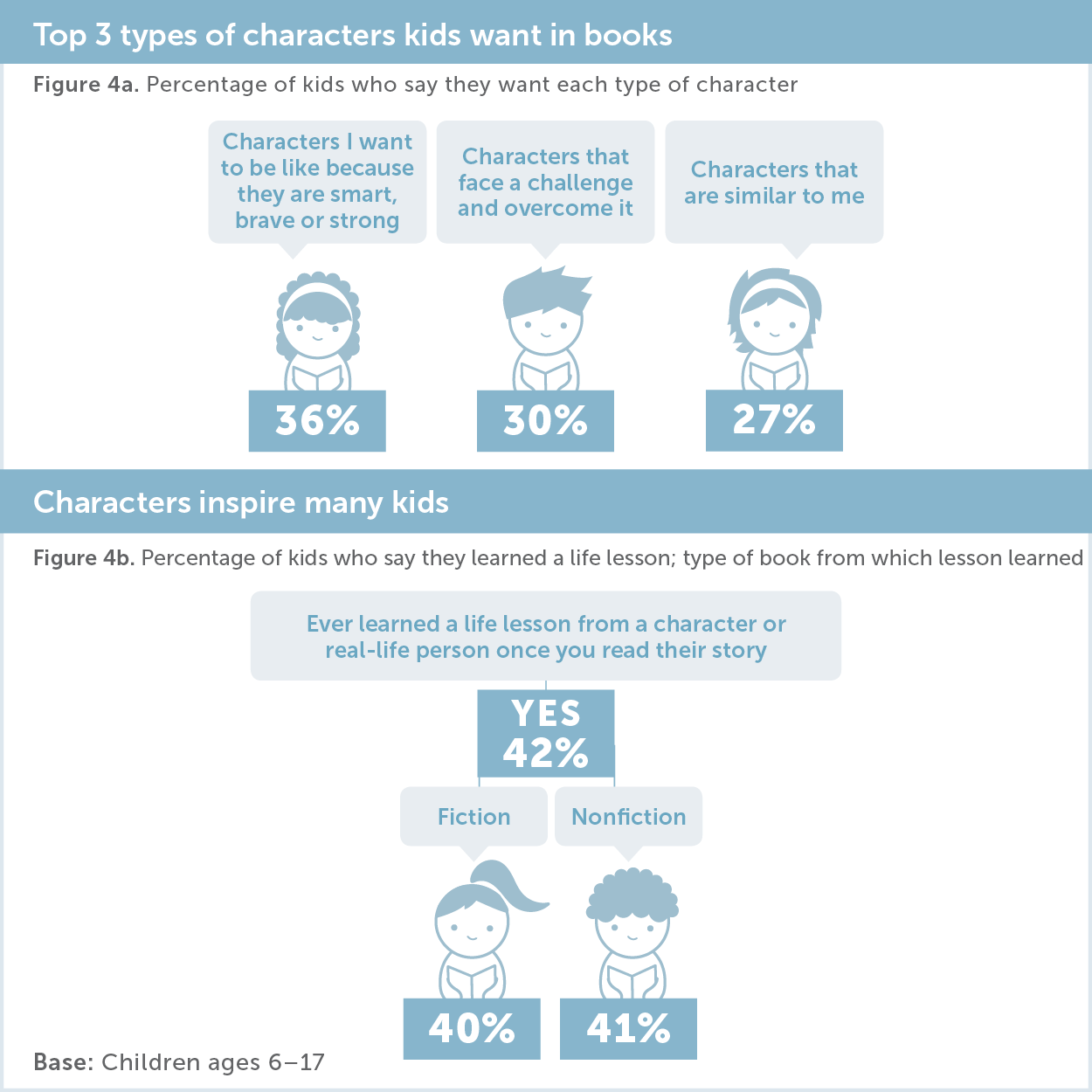
KIDS SEEK OUT AND LEARN FROM CHARACTERS
While a good story is, of course, a key factor that influences a parent or child’s desire for a book, a book’s characters are an important driver of preference and integral to the overall social-emotional benefits of reading. The top three types of characters kids ages 6–17 want in books do not vary across gender, age or ethnicity and reflect the reader’s own aspirations: characters who they want to be like because they are smart, brave or strong, who face and overcome challenges, and who are “similar to me” (see Figure 4a). A 13-year-old girl simply stated, "I like to read books [about] girls my age who can achieve things beyond reach, who overcome difficulties and become great.”
Overall, four in 10 kids agree that there has been a character—fictional or a real person—whose story taught them a life lesson. One 11-year-old girl shared that Auggie, a character from Wonder by R.J. Palacio, inspired her “because even though people made fun of him for the way he looked, he still found a way to make [it] through the day, every day…It just goes to show that you don’t have to be what someone thinks you should be, or act how someone thinks you should act. You just have to be you.” Many other children cited historical figures, with one 10-year-old girl saying of Martin Luther King, Jr.: “He taught me that you can be proud of your color and you can accomplish anything no matter who you are.”
Kids selected real-life people and fictional characters in equal numbers, illustrating the impact that both book formats can make in a child’s life (see Figure 4b).
Click Here For High-Resolution Image
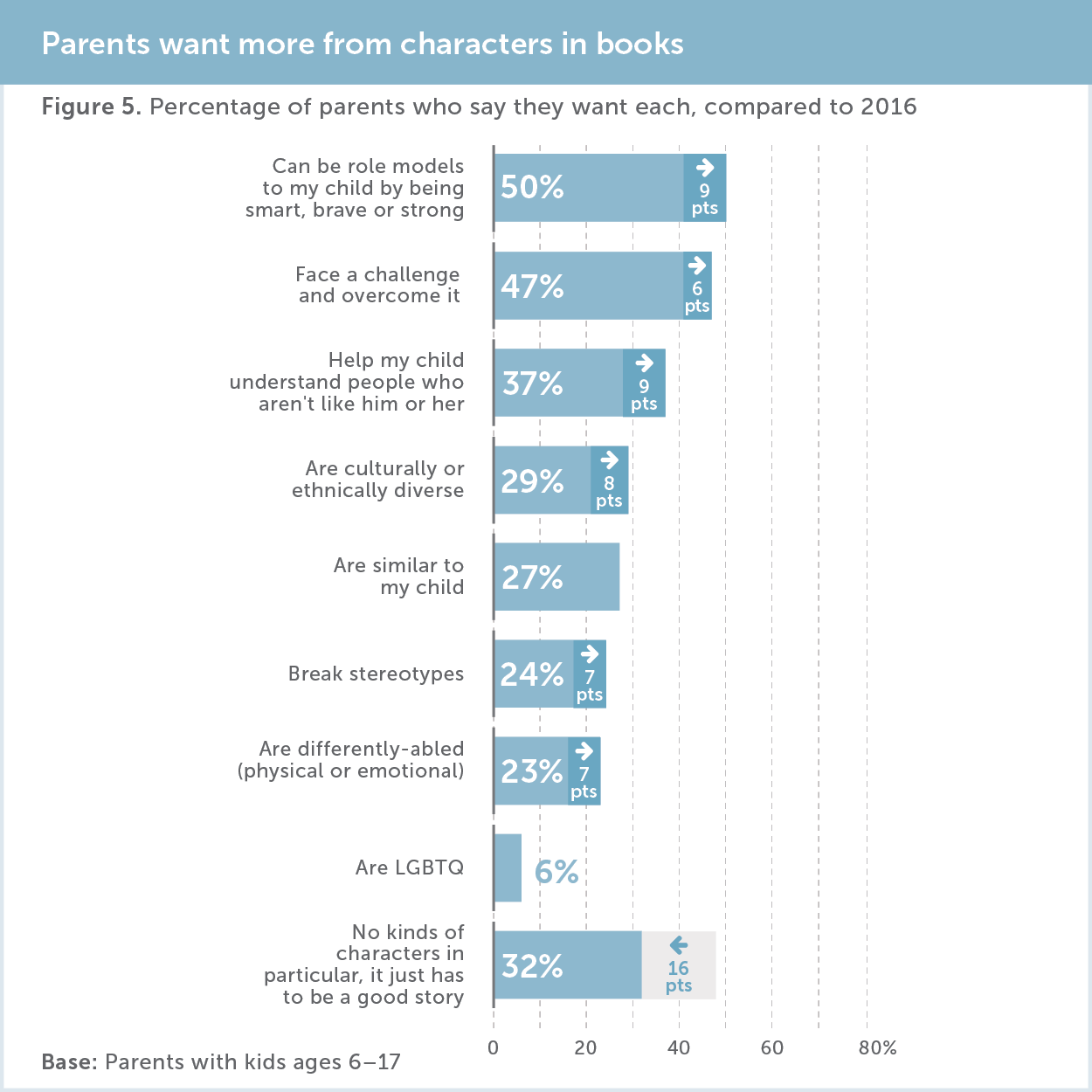
PARENTS KNOW THAT CHARACTERS BUILD CHARACTERS
To determine what parents value most, this year’s survey asked them to prioritize the qualities they hope their children develop as they grow. Responsibility, self-confidence, honesty, respectfulness and kindness top the list. Parents know that developing these qualities can be challenging, and they overwhelmingly agree that books and reading can help, with 95% agreeing that characters in books can help their children develop these positive qualities. A similar percentage of parents with children under five also agree.
A focus on character-building has increased since our last survey. In this edition, parents are more likely to want characters who:
- Can be role models to their children (50%, up nine points from 2016),
- Overcome challenges (47%, up six points),
- Help kids understand people who are not like them
(37%, up nine points), and
- Break stereotypes (24%, up seven points) (see Figure 5)
As one mom with a six-year-old daughter shared, “Not everyone is exactly the same as my child. So a vast selection of characters helps her understand more about the world around her.” A mother of an 11-year-old boy added, “Reading gives them confidence, curiosity, knowledge and expands their imagination.”
Click Here For High-Resolution Image
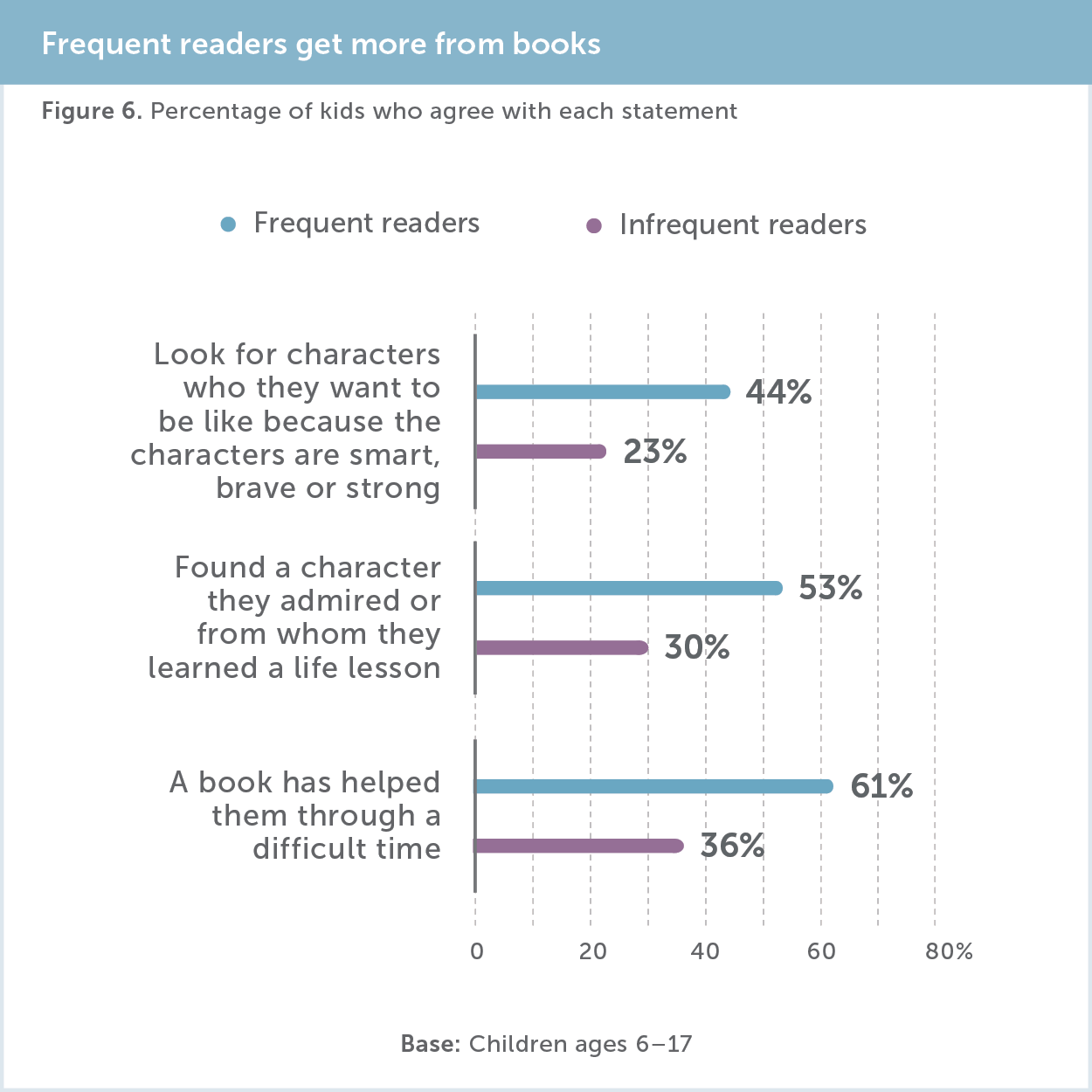
FREQUENT READERS WANT EVEN MORE FROM BOOKS AND CHARACTERS
The Kids & Family Reading Report punctuates that the more kids read, the more likely it is that the social-emotional side of literacy is reflected in their views on books and characters.
Frequent readers are more likely to say that reading fiction and nonfiction is a way to help them understand the world. They are also more likely to say that reading makes it easier to talk about and understand things that are happening in the world. Frequent readers are also more apt to seek out books with characters who they want to be like because the characters are smart, brave or strong; and perhaps due to this, they are more likely to say there is a character they have admired or learned a lot from. In the same vein, they more often say a book has helped them through a difficult time (see Figure 6).
Frequent readers ages 9–17 are more likely to say it is extremely or very important to them that the books they read include diversity (50% vs. 23% among infrequent readers). They are also more likely to define diversity in books as including people and experiences different than their own (57% vs. 49%), various settings and living situations (52% vs. 43%), people of color (36% vs. 26%) and differently-abled people (34% vs. 26%).
As one 17-year-old male, frequent reader shared, “I love to read books where I can either educate myself and learn more about someone's culture/ traditions/ ethnicity, or relate to characters I have major things in common with. It gives you someone to connect with even though they can be fictional characters.”


